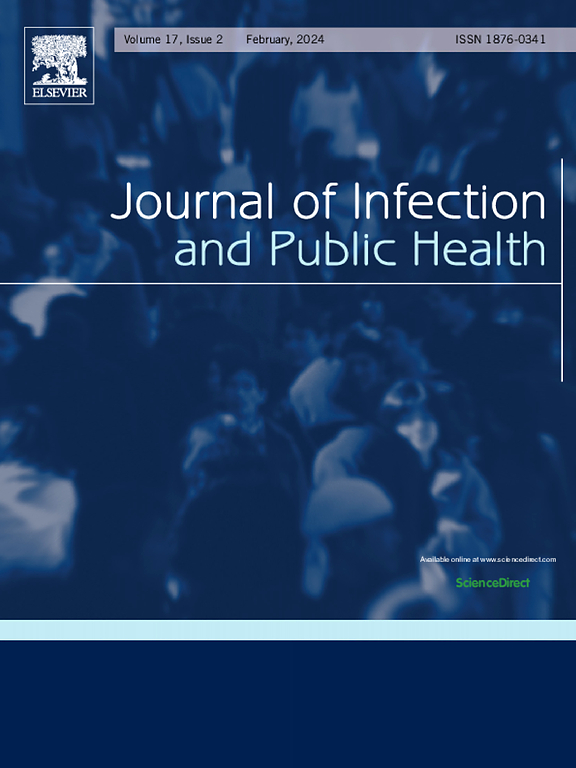系统回顾、荟萃分析和泛基因组分析预测,中国和印度特有的布鲁氏菌菌株将激增,阐明了加强防范的需求
IF 4.7
3区 医学
Q1 INFECTIOUS DISEASES
引用次数: 0
摘要
布鲁氏菌病是中低收入国家的一种传染病。它主要影响小型反刍动物(绵羊和山羊)种群,也可传播给哺乳动物(人类)。melitensis布鲁氏菌(B. melitensis)是主要病因,构成人畜共患威胁。控制羊角杆菌的传播,特别是在对人类和小型反刍动物具有高风险的地区,仍然具有挑战性。目前的研究探讨了布鲁氏菌病在反刍动物和人类中的流行、遗传多样性和传播预测。方法在本研究中,我们建立了一个综合数据库,提供了2003年至2024年禽畜中白蚁B. melitensis的发病率信息,并根据Cochran合作者的首选报告项目进行系统评价和荟萃分析,以评估患病率。利用信誉良好的资料来源进行了全面的文献检索。其中包括PubMed, ScienceDirect, Scopus, Biomed Central, CeRA, Krishikosh, ProQuest Dissertations &等知名电子数据库来源;论文全球和科学网络,由b谷歌学者搜索引擎补充。我们还使用了Zotero 5.0和Rayyan QCR这两个基于web的工具。预测发病率趋势的时间序列模型和确定亚洲和非洲遗传多样性的泛基因组分析。ResultsMeta-analysis透露一个总体患病率12 %的非洲大陆上升7 %(95 % CI: 5 - 8 %,I2 = 99 %,τ2 = 0.03,P = 0),而相应的流行在亚洲大陆构成12 %(95 % CI: 11 - 14 %,I2 = 99 %,τ2 = 0.02,P = 0)。时间序列模型预测,从2023年到2030年,布鲁氏菌病发病率呈上升趋势。泛基因组分析发现,来自中国的Rev 1(0.000712)和来自印度的CIIMS-PH-3(0.000209)菌株分支长度最高,具有较高的遗传多样性。结论这些发现强调了建立持续监测模型和研究以监测进化中的梅氏白僵菌景观的必要性。高流行区表现出显著的遗传多样性。有效预防;控制和响应&;防范战略至关重要,包括通过先进的诊断方法进行精确检测、建立强有力的监测模型以跟踪趋势以及对易感动物进行有针对性的疫苗接种。严格的检疫规程、生物安全措施以及探索草药作为常规治疗的补充方法,对于减轻作为公共卫生问题的布鲁氏菌病负担及其对生计的社会经济影响至关重要。本文章由计算机程序翻译,如有差异,请以英文原文为准。
Systematic review, Meta-analysis, and Pan-genome analytics predict the surging of Brucella melitensis by China and India-specific strains, elucidating the demand for enhanced preparedness
Background
Brucellosis is an infectious disease in lower to moderate-income countries. It primarily affects small ruminant (sheep and goat) populations and can also be transmitted to mammals (humans). Brucella melitensis (B. melitensis) is the primary cause, posing a zoonotic threat. Controlling the spread of B. melitensis, especially in regions with high risk to humans and small ruminants, remains challenging. Current research explores the prevalence, genetic diversity, and prediction of brucellosis transmission in ruminants and humans.
Methods
In this study, we developed an integrated database providing information on B. melitensis incidence in livestock from 2003 to 2024 and a systematic review and meta-analysis to assess the prevalence by following the Cochran collaborators’ Preferred Reporting Items for Systematic Reviews and Meta-analysis guidelines. A comprehensive literature search was conducted using reputable sources. These included reputable sources of electronic databases such as PubMed, ScienceDirect, Scopus, Biomed Central, CeRA, Krishikosh, ProQuest Dissertations & Theses Global, and Web of Science, complemented by the Google Scholar search engine. We also utilized Zotero 5.0 and Rayyan QCR, two web-based tools. Time series model to predict incidence trends and pan-genomic analysis to determine genetic diversity across Asia and Africa.
Results
Meta-analysis revealed an overall prevalence of 12 % of which the African continent rose at 7 % (95 % CI: 5–8 %, I2 = 99 %, τ2 = 0.03, P = 0), while the corresponding prevalence in the Asian continent constituted 12 % (95 % CI: 11–14 %, I2 = 99 %, τ2 = 0.02, P = 0). The Time series model predicts a rising trend in brucellosis incidence from 2023 to 2030. The pan-genome analysis identified Rev 1 (0.000712) strain from China and the CIIMS-PH-3 (0.000209) strains from India showed the highest branch length, considered to have more genetic diversity.
Conclusion
These findings underscore the critical need for ongoing surveillance models and research to monitor the evolving B. melitensis landscape. High-prevalence regions exhibit significant genetic diversity. Effective prevention & control and response & preparedness strategies, including precise detection through advanced diagnostics, robust surveillance models to track trends, and targeted vaccination of susceptible animals, are vital. Stringent quarantine protocols, biosecurity measures, and exploring herbal remedies as a complementary approach to conventional treatment are crucial to mitigate the brucellosis burden as a public health concern and its socioeconomic impact on livelihood.
求助全文
通过发布文献求助,成功后即可免费获取论文全文。
去求助
来源期刊

Journal of Infection and Public Health
PUBLIC, ENVIRONMENTAL & OCCUPATIONAL HEALTH -INFECTIOUS DISEASES
CiteScore
13.10
自引率
1.50%
发文量
203
审稿时长
96 days
期刊介绍:
The Journal of Infection and Public Health, first official journal of the Saudi Arabian Ministry of National Guard Health Affairs, King Saud Bin Abdulaziz University for Health Sciences and the Saudi Association for Public Health, aims to be the foremost scientific, peer-reviewed journal encompassing infection prevention and control, microbiology, infectious diseases, public health and the application of healthcare epidemiology to the evaluation of health outcomes. The point of view of the journal is that infection and public health are closely intertwined and that advances in one area will have positive consequences on the other.
The journal will be useful to all health professionals who are partners in the management of patients with communicable diseases, keeping them up to date. The journal is proud to have an international and diverse editorial board that will assist and facilitate the publication of articles that reflect a global view on infection control and public health, as well as emphasizing our focus on supporting the needs of public health practitioners.
It is our aim to improve healthcare by reducing risk of infection and related adverse outcomes by critical review, selection, and dissemination of new and relevant information in the field of infection control, public health and infectious diseases in all healthcare settings and the community.
 求助内容:
求助内容: 应助结果提醒方式:
应助结果提醒方式:


